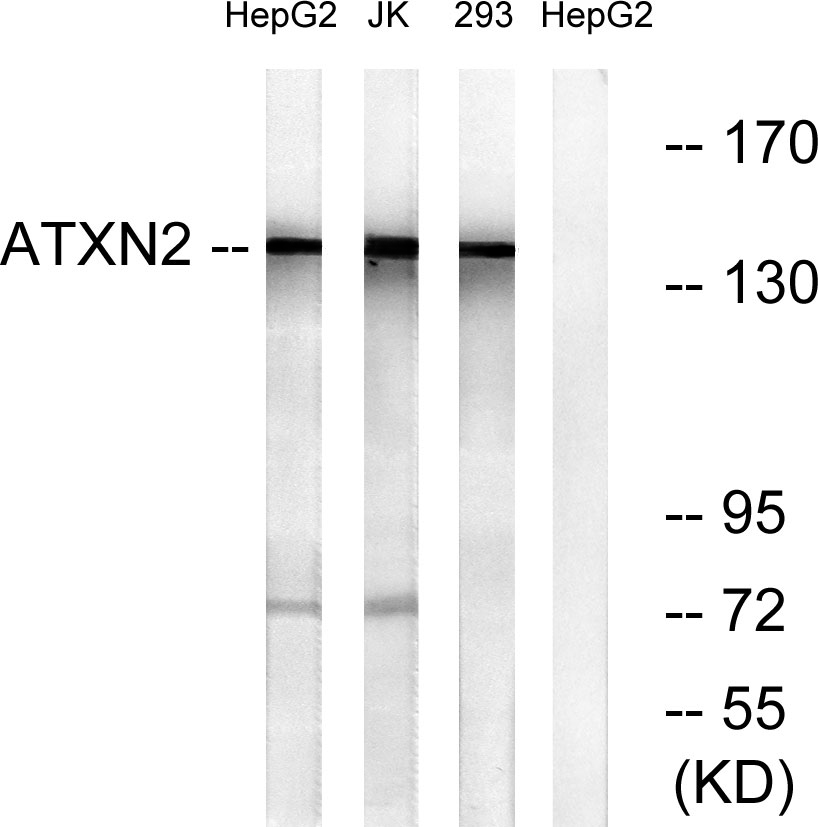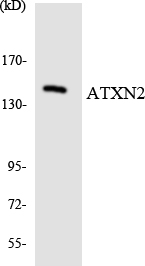产品名称
Ataxin-2 Rabbit Polyclonal Antibody
别名
ATXN2; ATX2; SCA2; TNRC13; Ataxin-2; Spinocerebellar ataxia type 2 protein; Trinucleotide repeat-containing gene 13 protein
存储缓冲液
Liquid in PBS containing 50% glycerol, 0.5% BSA and 0.02% New type preservative N.
Human Gene Link
http://www.ncbi.nlm.nih.gov/sites/entrez?db=gene&term=6311
Human Swissprot No.
Q99700
Human Swissprot Link
http://www.uniprot.org/uniprotkb/Q99700/entry
Mouse Swissprot No.
O70305
Mouse Swissprot Link
http://www.uniprot.org/uniprot/O70305
免疫原
The antiserum was produced against synthesized peptide derived from human ATXN2. AA range:731-780
特异性
Ataxin-2 Polyclonal Antibody detects endogenous levels of Ataxin-2 protein.
稀释度
WB 1:500 - 1:2000. IHC 1:100 - 1:300. ELISA: 1:20000.. IF 1:50-200
宿主
Polyclonal, Rabbit,IgG
背景介绍
ataxin 2(ATXN2) Homo sapiens This gene belongs to a group of genes that is associated with microsatellite-expansion diseases, a class of neurological and neuromuscular disorders caused by expansion of short stretches of repetitive DNA. The protein encoded by this gene has two globular domains near the N-terminus, one of which contains a clathrin-mediated trans-Golgi signal and an endoplasmic reticulum exit signal. The protein is primarily localized to the Golgi apparatus, with deletion of the Golgi and endoplasmic reticulum signals resulting in abnormal subcellular localization. In addition, the N-terminal region contains a polyglutamine tract of 14-31 residues that can be expanded in the pathogenic state to 32-200 residues. Intermediate length expansions of this tract increase susceptibility to amyotrophic lateral sclerosis, while long expansions of this tract result in spinocerebellar ataxia-2, an autosomal-dominantly inherited, neurodegener
组织表达
Expressed in the brain, heart, liver, skeletal muscle, pancreas and placenta. Isoform 1 is predominant in the brain and spinal cord. Isoform 4 is more abundant in the cerebellum. In the brain, broadly expressed in the amygdala, caudate nucleus, corpus callosum, hippocampus, hypothalamus, substantia nigra, subthalamic nucleus and thalamus.
功能
disease:Defects in ATXN2 are the cause of spinocerebellar ataxia type 2 (SCA2) [MIM:183090]; also known as olivopontocerebellar atrophy II (OPCA II or OPCA2). Spinocerebellar ataxia is a clinically and genetically heterogeneous group of cerebellar disorders. Patients show progressive incoordination of gait and often poor coordination of hands, speech and eye movements, due to cerebellum degeneration with variable involvement of the brainstem and spinal cord. SCA2 belongs to the autosomal dominant cerebellar ataxias type I (ADCA I) which are characterized by cerebellar ataxia in combination with additional clinical features like optic atrophy, ophthalmoplegia, bulbar and extrapyramidal signs, peripheral neuropathy and dementia. SCA2 is characterized by hyporeflexia, myoclonus and action tremor and dopamine-responsive parkinsonism. SCA2 is caused by expansion of a CAG repeat in the coding region of ATXN2. Longer expansions result in earlier onset of the disease. In some patients with smaller CAG repeat expansions, SCA2 presents as pure familial parkinsonism without cerebellar signs.,polymorphism:The poly-Gln region of ATXN2 is polymorphic: 17 to 29 repeats in the normal population, expanded to about 36 to 52 repeats in spinocerebellar ataxia 2 (SCA2) patients.,similarity:Belongs to the ataxin-2 family.,subunit:Monomer (By similarity). Can also form homodimers.,tissue specificity:Expressed in the brain, heart, liver, skeletal muscle, pancreas and placenta. Isoform 1 is predominant in the brain and spinal cord while isoform 4 is more abundant in the cerebellum. In the brain, broadly expressed in the amygdala, caudate nucleus, corpus callosum, hippocampus, hypothalamus, substantia nigra, subthalamic nucleus and thalamus.,
纯化
The antibody was affinity-purified from rabbit antiserum by affinity-chromatography using epitope-specific immunogen.



.jpg)
